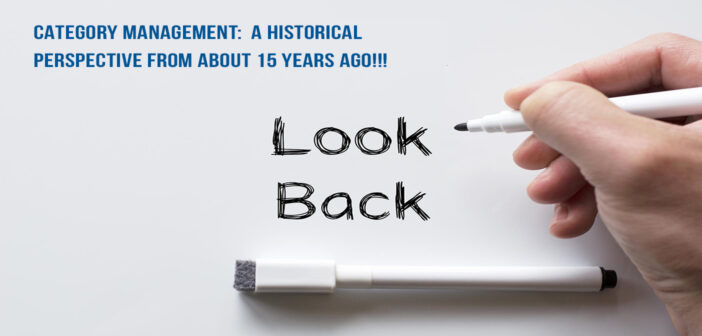We were working with an international manufacturing client and still do occasionally, and we were asked to help them transition into Category Management (“CM”) which they had recently heard about. This was a client that had recently made the move to Strategic Sourcing from 3 bids and a buy and probably should have taken some time to fully embrace and adopt that before moving on to Category Management – a frequent misstep. We have run into that challenge multiple times.
We did a lot of research to determine what was out there on the topic of Category Management – remember this was 15 years ago and the term was just gaining traction-and there was very little available, and I mean hardly anything worthwhile. So here is a simple construct that we came up with and surprisingly, it still holds up as the core elements of CM? We have of course significantly revised and enhanced it since then but have not deviated significantly from it. We broke it up into three buckets on either side of Strategic Sourcing.

And here were the sub-elements under each of these. For the strategy component, we used the following definitions:
Establish Category Management Strategy
A) Business Objectives and Needs
- P&L/Financial Needs
- Innovation Requirements
- Customer/Sales Needs
- Risk Management Needs
B) Category Understanding
- Spend Analysis
- Category Definitions
- Stakeholder Analysis
- Supply Market Analysis
- Cost/Value Drivers
C) Supply Market Strategy
- Global vs. Regional
Local - Cost Driver Summary
- Capacity Management Planning
- LCCS Opportunities
- Bundle/Unbundle
- Supplier Development
D) Demand Management Strategy
- Design Parameters e.g. Custom vs. Standard
- Make vs. Buy Analysis
- Forecast
E) Collaboration/Location Strategy
- Sub-Category scope
- Team makeup and
involvement strategy - Location strategy
- Category Alignment
Analysis
F) Execution Strategy
- Risk Exposure Analysis
- Risk Management Plan
- Category Value Drivers
- Category Implementation Plan
- Stakeholder Analysis
- Communication Plan
Please keep in mind that this was a global manufacturing client. I won’t go into the details of the second chevron (Strategic Sourcing) but I do think diving into the third chevron does add some value. And keep in mind that this was 15 years ago!!!
We called it “Embed the Change/Extract Value” at that time and here is how we defined it then:
- A) Sustain Value and build Value Proposition across the Supply
- New Supplier Development
- Category Capacity Management
- Supply Base Strategic Management
- Make vs. Buy
- Customer Sales/Selling Support
- Value Leakage Identification
- New Market Identification
- Product Innovation
B) Institutionalize the new Category Management culture / mindset
- Embed Category Management knowledge into the organization
- Continuously sell to stakeholders
- Communicate successes
- Integrate best practices into product lines
- Adopt performance metrics
Hopefully you can see that the client was making a very ambitious and bold statement by adopting this definition of Category Management and they did end up making significant progress on a number of these sub-elements. Given that this was 15 years ago, they deserve a lot of recognition for taking this giant leap. We also learned a lot from this engagement, and it helped identify us as a pioneer in Category Management 😊.


